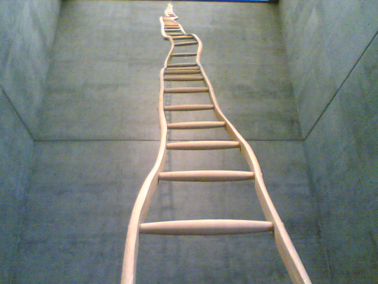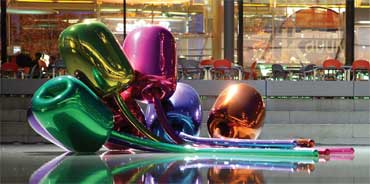 A Jeff Koons planted in the yard of the new American embassy in China. And not just a Koons “Tulips” sculpture, either. Work by Maya Lin and Louise Bourgeois will also be there. Robert Rauschenberg and Martin Puryear, too. According to the Art Newspaper, the U.S. government is spending $800,000 on (mostly) commissioned artworks for the embassy, a mix of Chinese and American artists. And for once, I’m totally aligned with American foreign policy. China needs the subversion of Puryear, the gentle suggestions of Lin and maybe even the imaginative flights of Koons, which should fit in well in the go-go Chinese economy. A very small number of people will see them, of course, but it’s the idea of the thing: Art suggests an alternative reality, an alternative foreign policy, a new way of thinking about things. And if I were a Kantian, I might suggest a new Spirit.
A Jeff Koons planted in the yard of the new American embassy in China. And not just a Koons “Tulips” sculpture, either. Work by Maya Lin and Louise Bourgeois will also be there. Robert Rauschenberg and Martin Puryear, too. According to the Art Newspaper, the U.S. government is spending $800,000 on (mostly) commissioned artworks for the embassy, a mix of Chinese and American artists. And for once, I’m totally aligned with American foreign policy. China needs the subversion of Puryear, the gentle suggestions of Lin and maybe even the imaginative flights of Koons, which should fit in well in the go-go Chinese economy. A very small number of people will see them, of course, but it’s the idea of the thing: Art suggests an alternative reality, an alternative foreign policy, a new way of thinking about things. And if I were a Kantian, I might suggest a new Spirit.
Here’s Arthur C. Danto in The Nation, describing the work of Puryear at a MoMA exhibition late last year:
Once in a while, an artist appears whose work has high meaning and great craft but, most important, embodies what Kant, in the dense, sparse pages in which he advances his theory of art, called Spirit. “We say of certain products of which we expect that they should at least in part appear as beautiful art, they are without spirit, though we find nothing to blame in them on the score of taste,” Kant wrote. I’d like to revive the term for critical discourse. Not a single piece here is without spirit, which is in part what makes this exhibition almost uniquely exhilarating.
As the American experiment in democracy has foundered in recent decades (we could argue about this, but let’s just let the assertion stand for now, yes?), American artists have become more acute about it — pointing out failures, suggesting repairs, expressing anger and embarrassment. The most concentrated dose of oppositional politics I get in Portland, is in the art galleries (and maybe you could add the clubs, theaters and independent cinemas). At its best, it achieves the nuance of Puryear, which is what attracts philosopher Danto the most, perhaps, but it is awash in spirit. And I find I need it.
 China? Yes, China needs it, too. The Chinese paintings described in the linked article show that artists there are just as sensitive to the human and environmental costs of China’s Market Authoritarianism as our artists are to their situation. And the idea of dropping Francis Bacon paintings into Qatar and raising Guggenheims and Louvres in Abu Dhabi, as we’ve remarked earlier? It will be fun to see the Picassos do their stuff — I suspect that the locals won’t be allowed to see them after a while. Too hot to handle.
China? Yes, China needs it, too. The Chinese paintings described in the linked article show that artists there are just as sensitive to the human and environmental costs of China’s Market Authoritarianism as our artists are to their situation. And the idea of dropping Francis Bacon paintings into Qatar and raising Guggenheims and Louvres in Abu Dhabi, as we’ve remarked earlier? It will be fun to see the Picassos do their stuff — I suspect that the locals won’t be allowed to see them after a while. Too hot to handle.